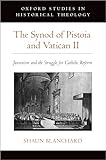The Synod of Pistoia and Vatican II : Jansenism and the struggle for Catholic reform / Shaun Blanchard.
Material type: TextSeries: Oxford studies in historical theologyPublisher: New York, NY : Oxford University Press, [2020]Copyright date: c2020Description: xvi, 346 pagine ; 25 cmContent type:
TextSeries: Oxford studies in historical theologyPublisher: New York, NY : Oxford University Press, [2020]Copyright date: c2020Description: xvi, 346 pagine ; 25 cmContent type: - testo (txt)
- senza mediazione (n)
- volume (nc)
- 9780190947798
- 262/.52 23
- BX1547.P495 B53 2020
- BQX 2577.P63.B53 2020
| Item type | Current library | Call number | Status | Barcode | |
|---|---|---|---|---|---|
 Opera (Magaz.)
Opera (Magaz.)
|
Biblioteca "Angelicum" Pont. Univ. S.Tommaso d'Aquino Temporary Library | BQX 2577.P63.B53 2020 (Browse shelf(Opens below)) | Available | 0030215807 |
Browsing Biblioteca "Angelicum" Pont. Univ. S.Tommaso d'Aquino shelves, Shelving location: Temporary Library Close shelf browser (Hides shelf browser)
Include bibliografia (pagine 313-335) e indice.
Introduction: how far back do the roots of the council go? -- A hermeneutic of true reform: interpreting Vatican II -- Ressourcement and aggiornamento in the eighteenth century -- Radical reform in Tuscany: Scipione de'Ricci and late Jansenism -- The Synod of Pistoia: radical forerunner of Vatican II -- The spirit of Pistoia: the reception and failure of a bold reformist vision -- The ghost of Pistoia: the legacy of Auctorem fidei at Vatican II -- Conclusion: the memory of Pistoia and the hermeneutic of true reform.
"This book sheds further light on the nature of church reform and the roots of the Second Vatican Council (1962-65) through a study of eighteenth-century Catholic reformers who anticipated the Council. The most striking of these examples is the Synod of Pistoia (1786), the high-water mark of late Jansenism. Most of the reforms of the Synod were harshly condemned by Pope Pius VI in the Bull Auctorem fidei (1794), and late Jansenism was totally discredited in the ultramontane nineteenth-century Church. Nevertheless, much of the Pistoian agenda - such as an exaltation of the role of bishops, an emphasis on infallibility as a gift to the entire Church, religious liberty, a simpler and more comprehensible liturgy that incorporates the vernacular, and the encouragement of lay Bible reading and Christocentric devotions - was officially promulgated at Vatican II. The career of Bishop Scipione de'Ricci (1741-1810) and the famous Synod he convened are investigated in detail. The international reception (and rejection) of the Synod sheds light on why these reforms failed, and the criteria of Yves Congar are used to judge the Pistoian Synod as "true or false reform." This book proves that the Synod was a "ghost" present at Vatican II. The council fathers struggled with, and ultimately enacted, many of the same ideas. This study complexifies the story of the roots of the Council and Pope Benedict XVI's "hermeneutic of reform," which seeks to interpret Vatican II as in "continuity and discontinuity on different levels" with past teaching and practice. Vatican II, Second Vatican Council, ressourcement, Jansenism, Synod of Pistoia, Scipione de' Ricci, Yves Congar, Benedict XVI, development of doctrine, Catholic Enlightenment".







